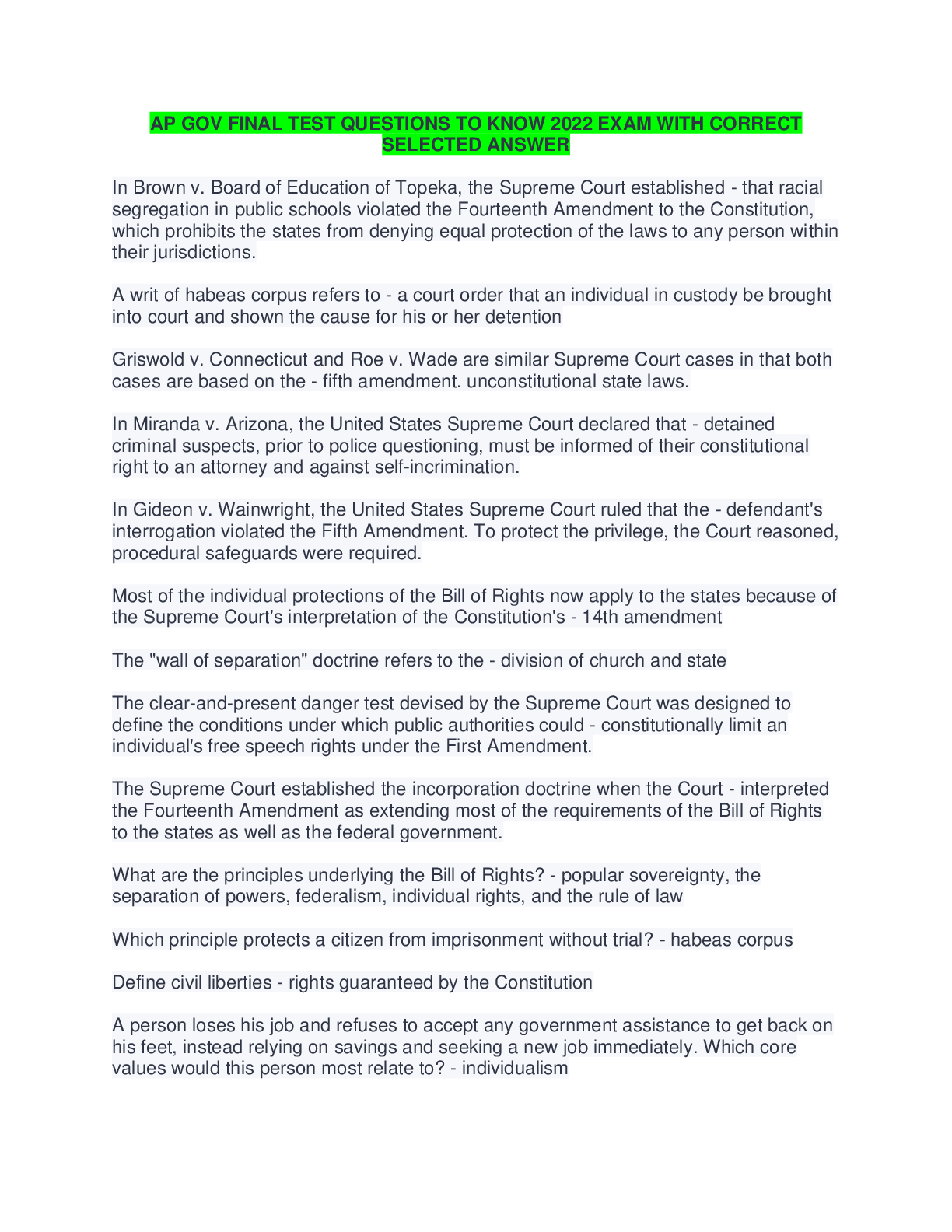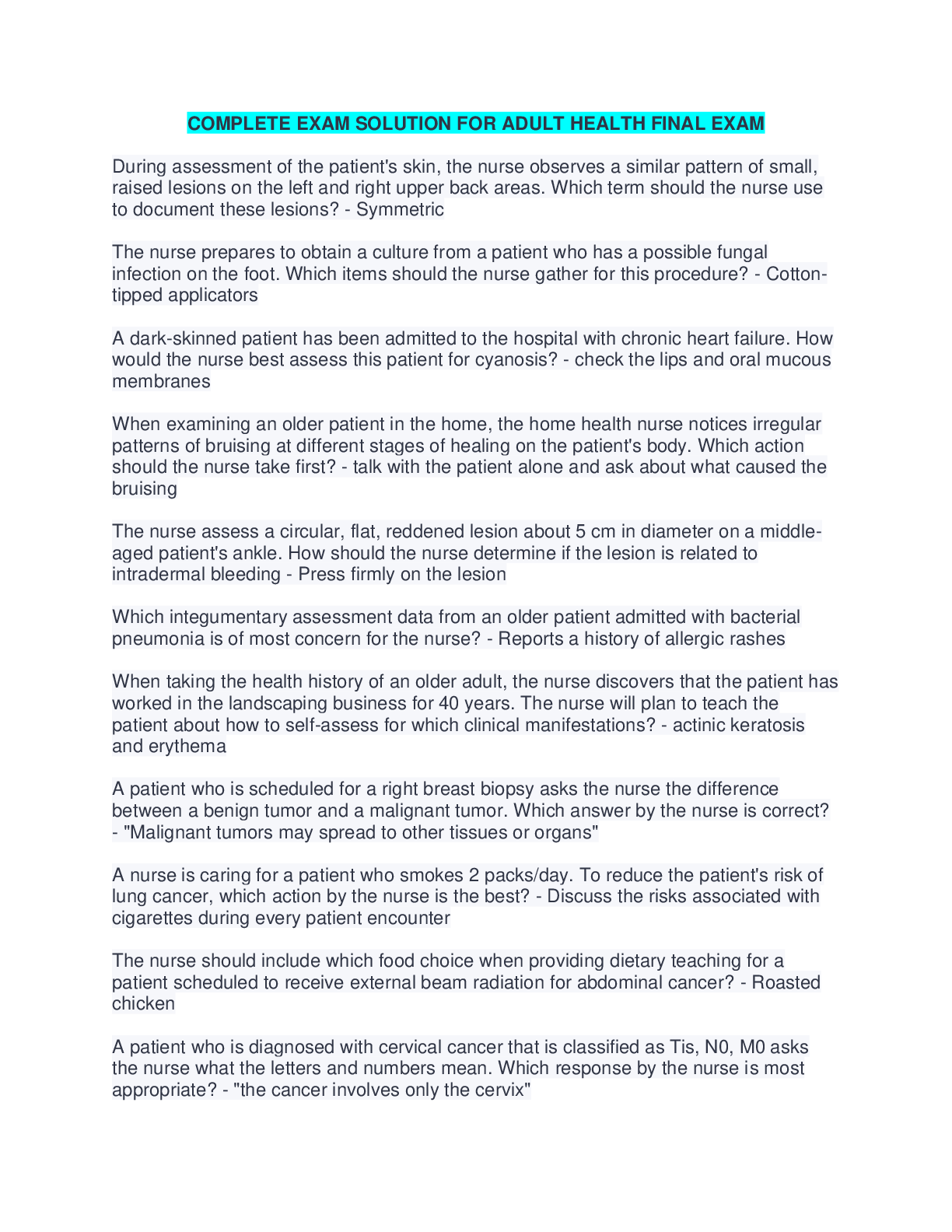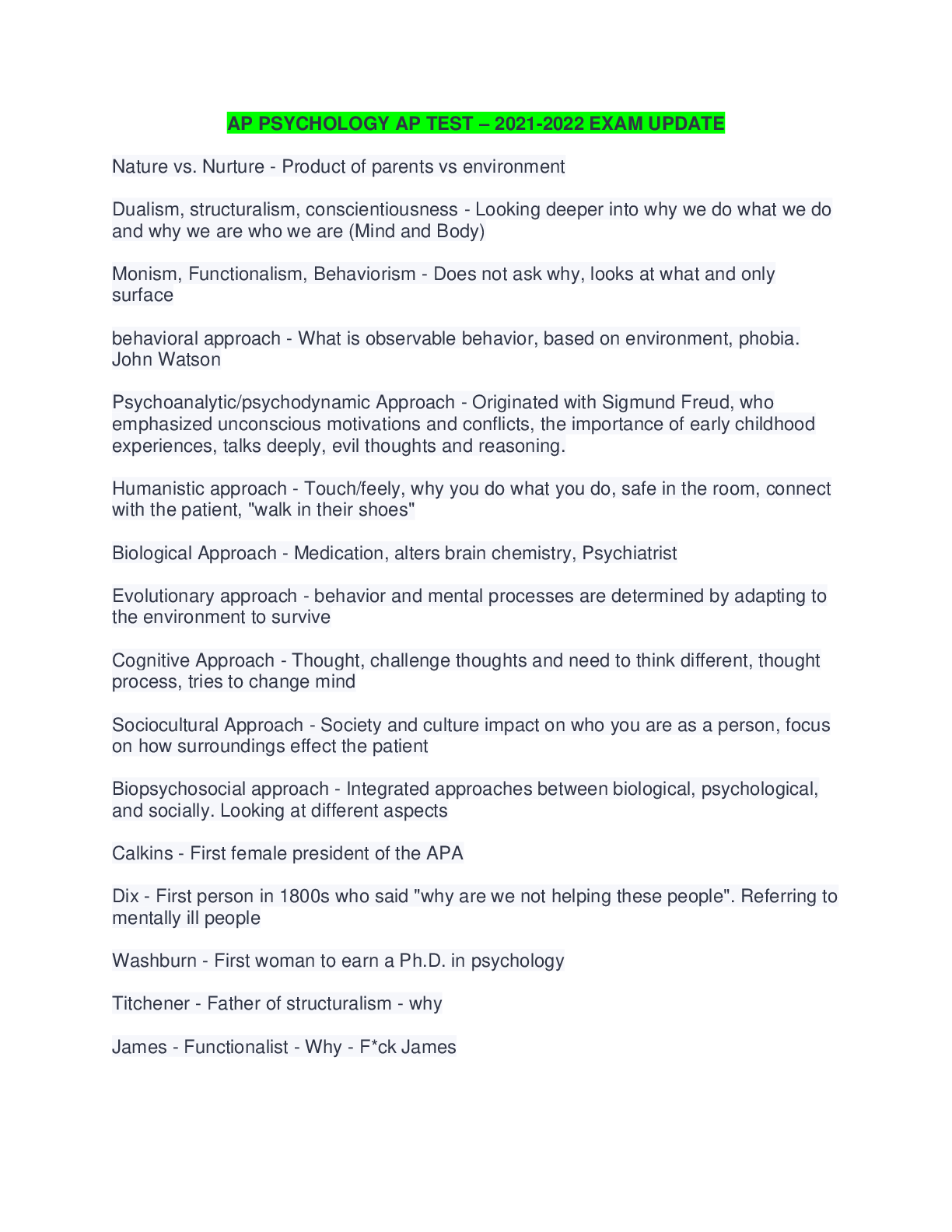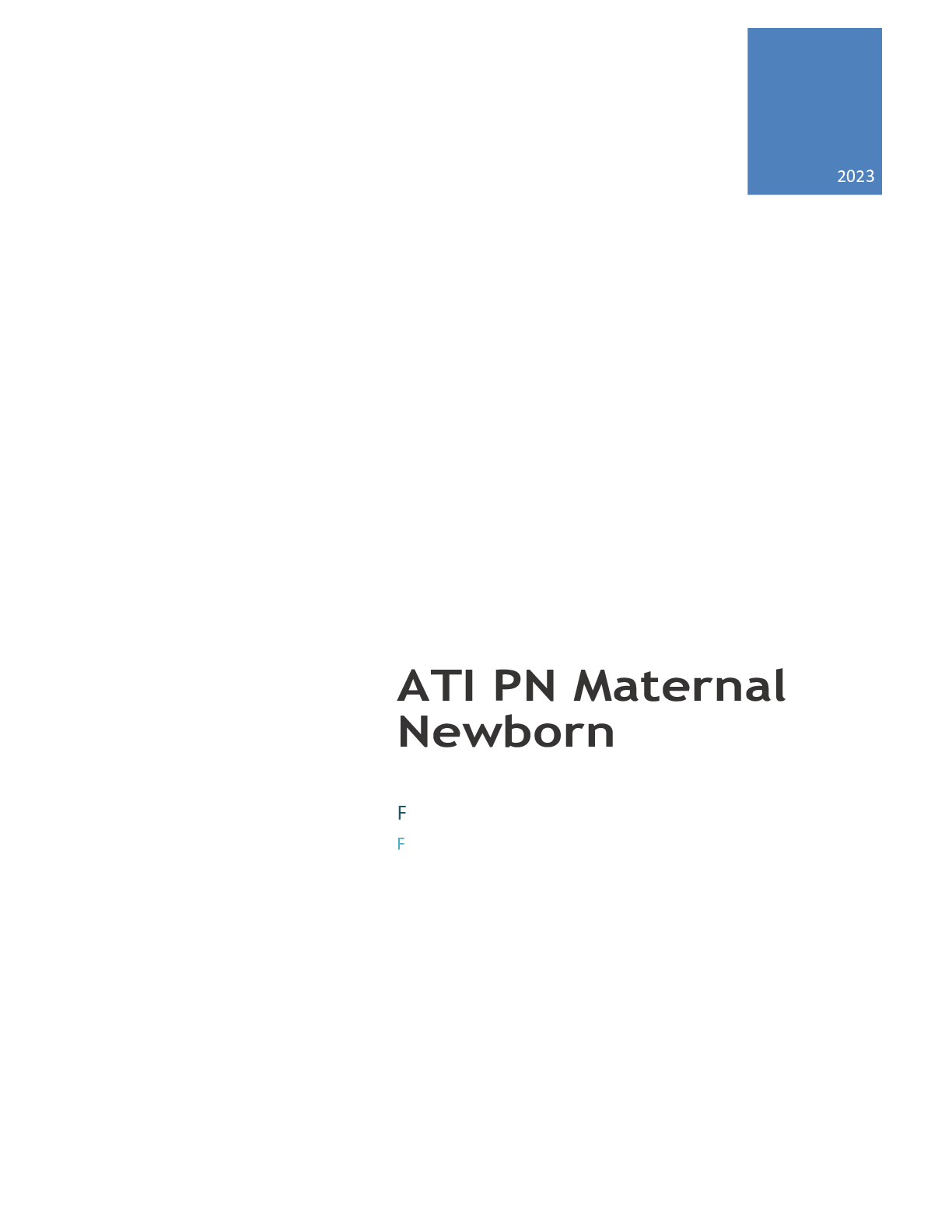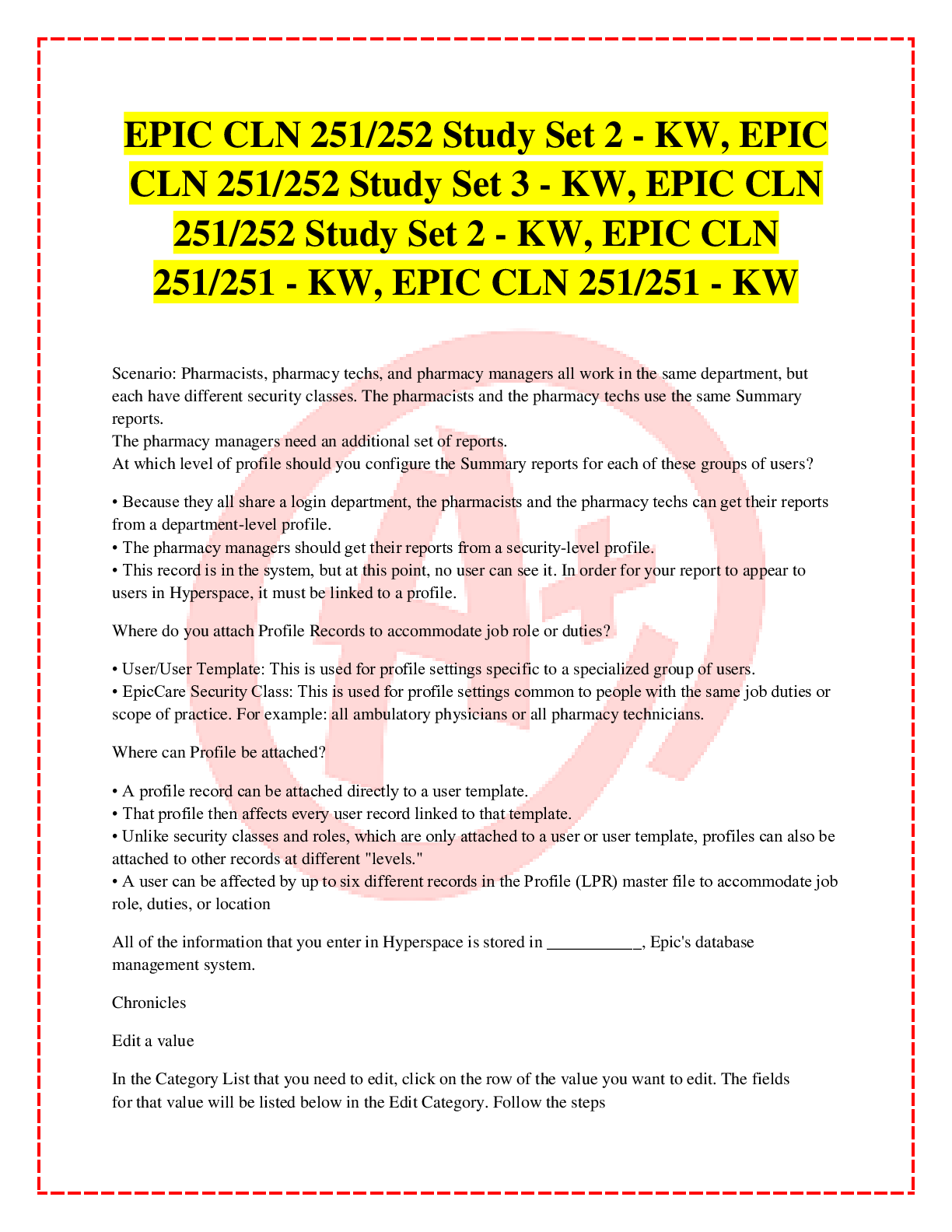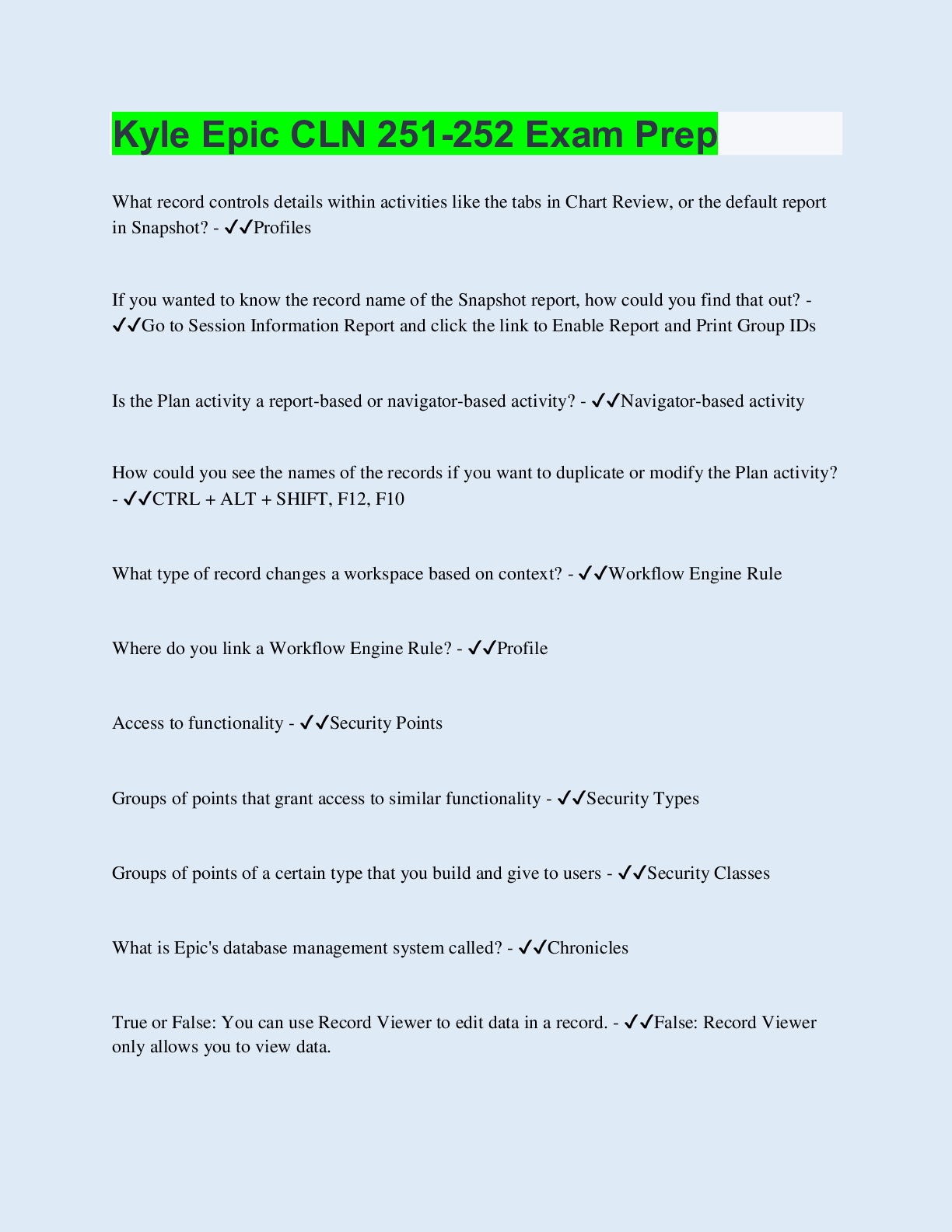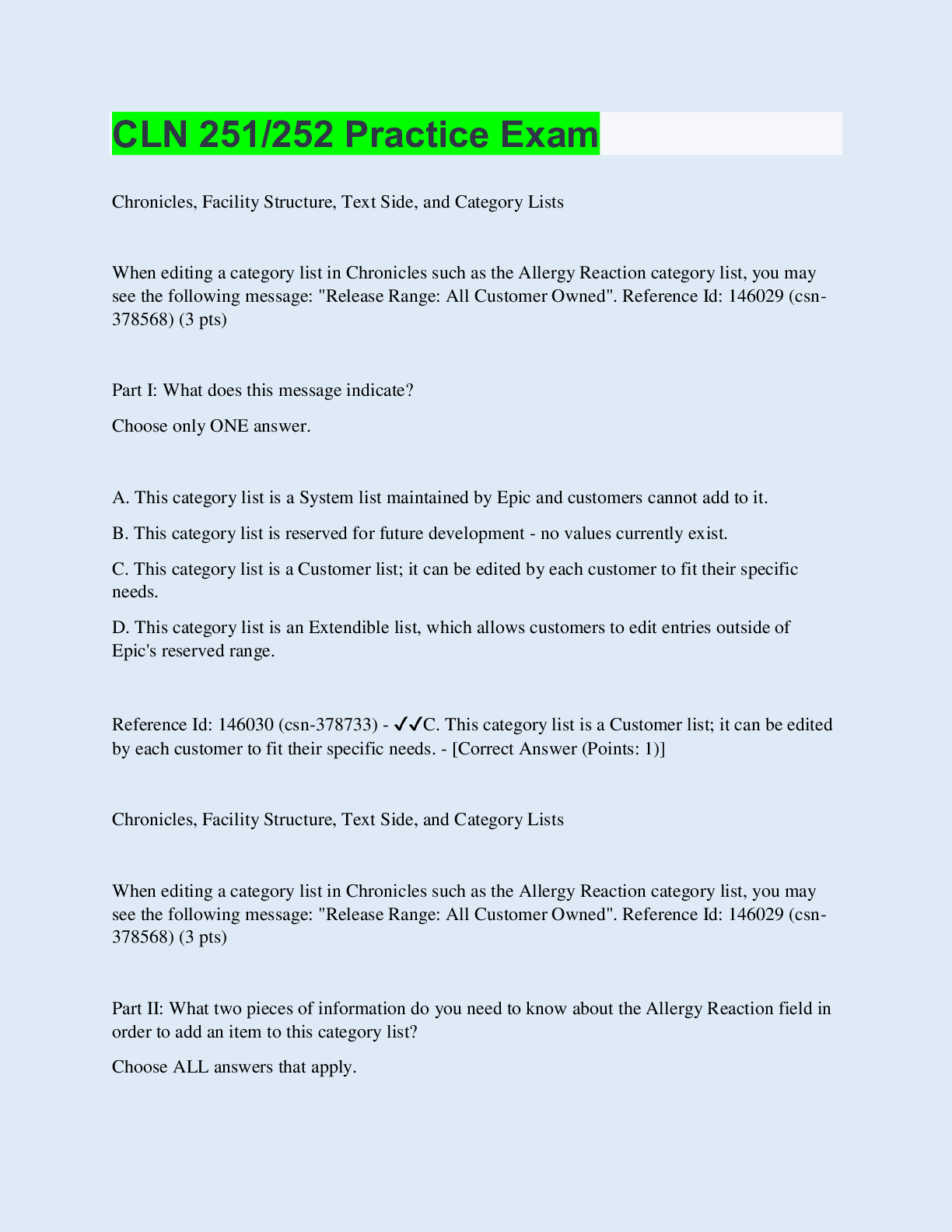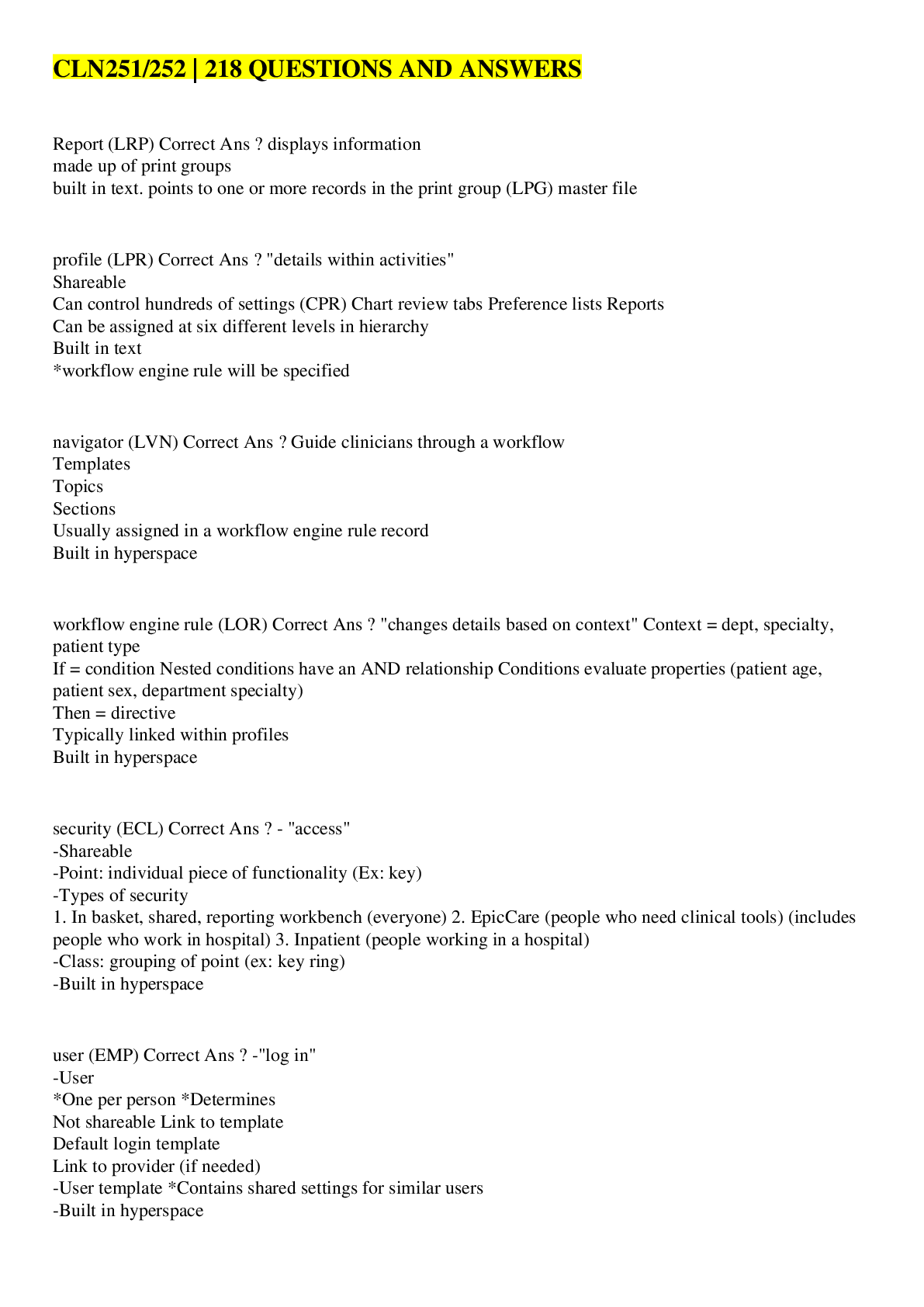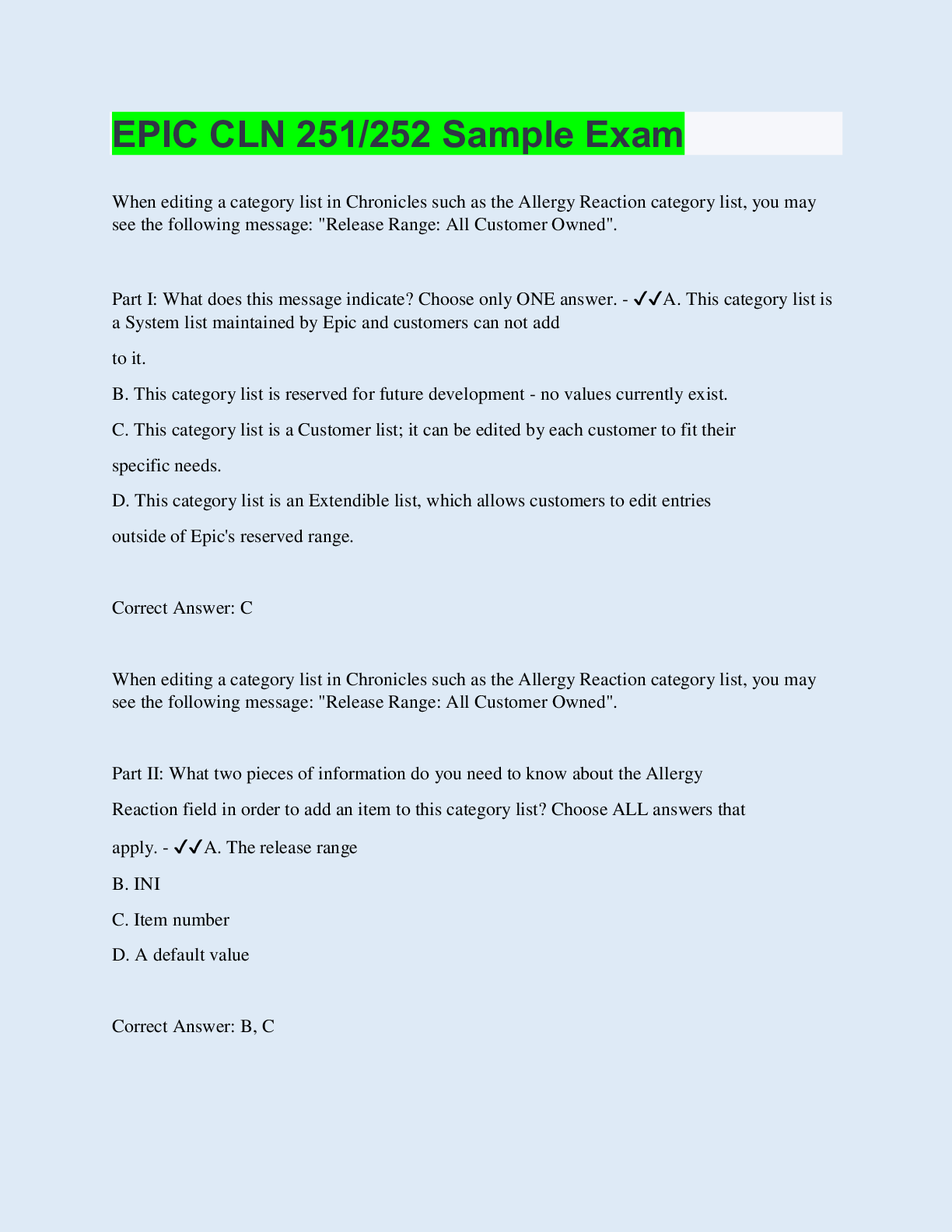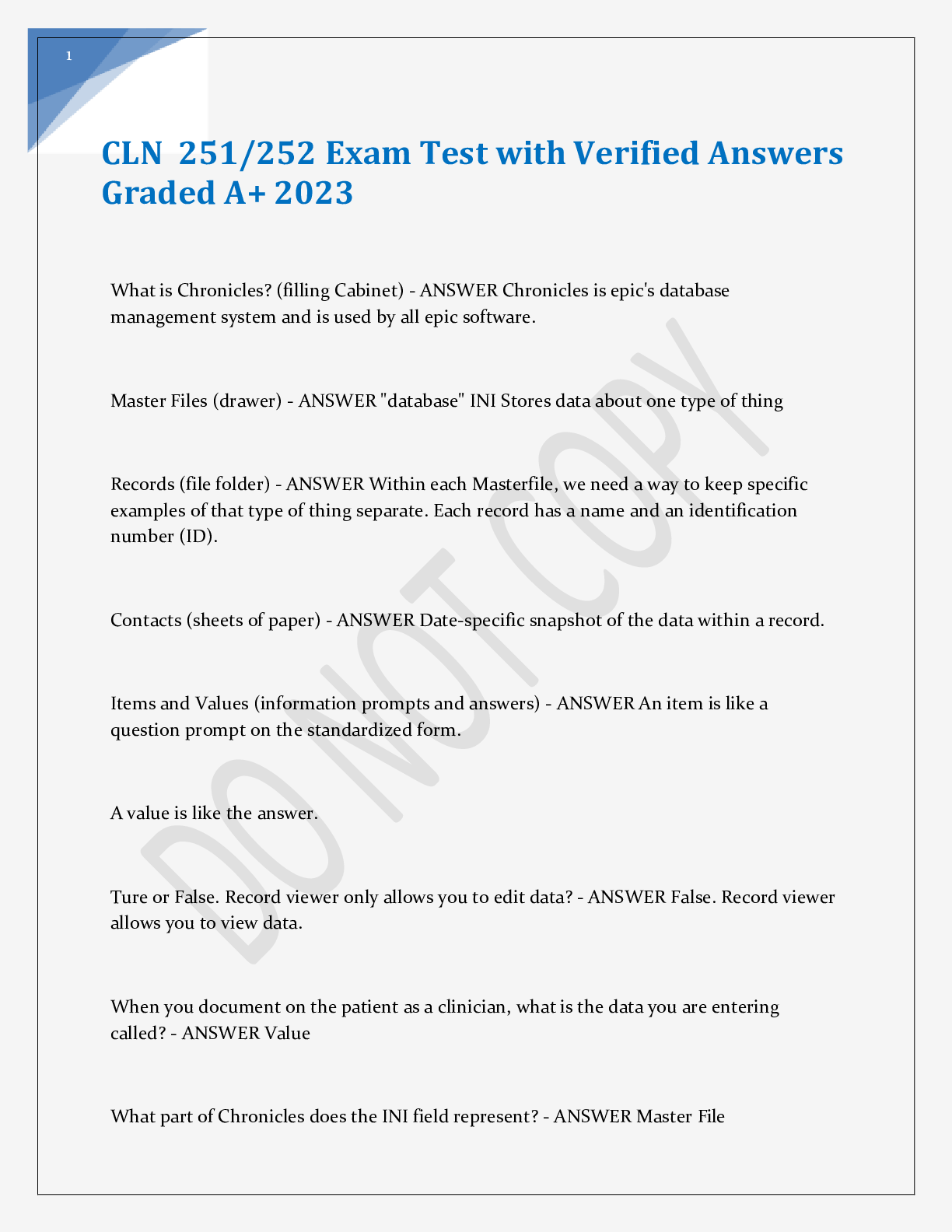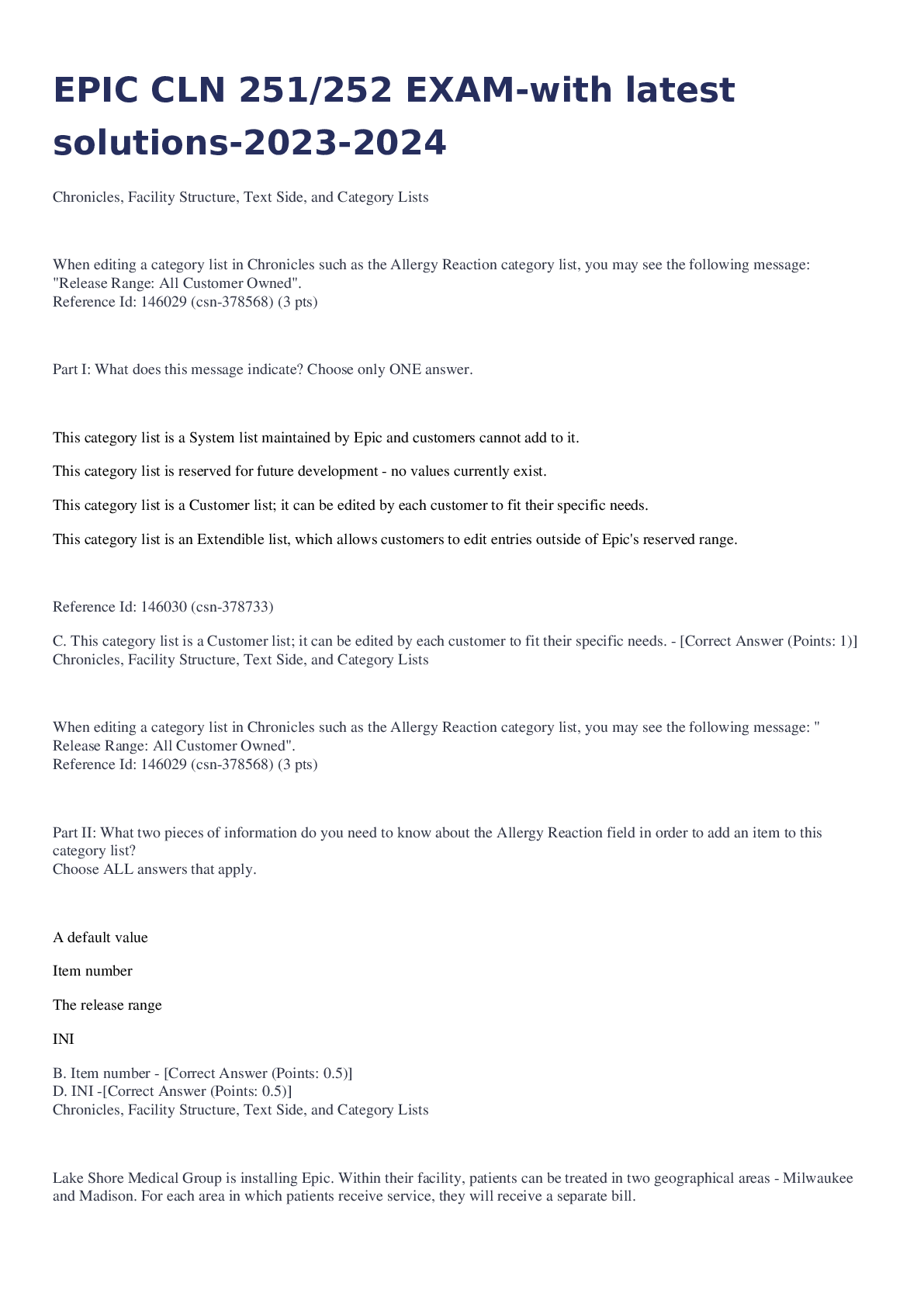RN MATERNAL NEWBORN ATI 2016
Document Content and Description Below
RN MATERNAL NEWBORN ATI 2016 1. A nurse is performing an initial assessment of a newborn who was delivered with a nuchal cord. Which of the following clinical findings should the nurse expect? A. T... elangiectactic nevi • Pink, flat. Birth mark that appears in first months of life (forehead, eyelids, nose, upper lip, back/neck) considered normal B. Periauricular papillomas • Couldn’t find any info on this. Most likely a squamous growth on ear, not cancerous and not dangerous (per Google) C. Erythema toxicum • Common rash seen in full term newborns. Appears in first days after birth and fades within a week. Transient maculopapular rash. Newborn rash considered normal and no treatment is needed D. Facial petechiae • Petechiae is present when there is birth trauma. Seen most often with soft tissue injuries. 2. A nurse is monitoring a newborn whose mother reports recent opiate use for neonatal abstinence syndrome. Which of the following findings indicates narcotic withdrawal? A. Respiratory rate 50/min • Tachypnea greater than 60/min B. Unequal pupils • Small eyes C. Hypotonia (boggy muscles) • Hyperactive reflexes and increased muscle tone are common D. Excessive crying • Common finding in newborns to whom mothers were opiate users 3. A nurse is caring for a client who is in the second stage of labor. The nurse observes the fetal head retract against the client’s perineum immediately following emergence. Which of the following actions should the nurse take? (turtle sign) A. Assess fetal position using Leopold maneuvers • External palpations of the maternal uterus through the abdominal wall to determine: number of fetuses, presenting part, fetal lie + attitude, degree of descent, location of the fetus’s back B. Reposition the client in the left lateral position • Used if fetus is in distress during first stage of labor C. Apply pressure to the client’s suprapubic area D. Empty the client’s bladder using Crede’s maneuver • This is mostly used post-partum if mother cannot empty bladder 4. A client and her partner ask the nurse for information about permanent contraception. Which of the following statements should the nurse include in the counseling? A. “A man is usually sterile immediately after a vasectomy.” • Sterility is delayed until the proximal portion of the vas deferens is cleared of all remaining sperm (20 ejaculations). Alternate forms of birth control is needed B. “The menstrual cycle is shorter after a tubal ligation.” • It is the same/longer after tubal ligation C. “Most sterilization procedures are considered irreversible.” • Female sterilization is irreversible but male is reversible (not always successful) D. “A woman should use contraception for 1 to 2 months after a tubal ligation.” • Must use contraception up to 3 months post tubal ligation 5. A nurse is providing education to a client who is to receive misoprostol for induction of labor. Which of the following instructions should the nurse include in the teaching? A. “I will insert a urinary catheter before I administer the medication.” B. “I will begin an oxytocin infusion within 2 hours of your last dose of medication” C. “You will lie on your side for 40 minutes after I administer the medication.” D. “You will receive an antacid containing magnesium before the medication.” 6. A nurse is assessing a client who is in her second trimester for common physiological changes during pregnancy. The nurse notes a blotchy discoloration on the client’s forehead, nose, and cheeks. Which of the following changes should the nurse document? A. Linea nigra • Dark line of pigmentation from the umbilicus extending to the pubic area B. Epulis • Tumor/ enlargement mucosa C. Striae gravidarum • Stretch marks on the abdomen and thighs D. Chloasma • Increased pigmentation on the face 7. A change nurse is discussing STIs with a newly licensed nurse. Which of the following infections should the nurse include in the teaching as an indication for a cesarean birth? A. Gonorrhea B. Chlamydia ?C. HIV • Page 47 “schedule Cesarean birth” D. Syphilis 8. A nurse if planning care for a newborn who has neonatal abstinence syndrome. Which of the following interventions should the nurse include in the plan of care? A. Increase the newborn’s visual stimulation • Decrease environmental stimuli B. Swaddle the newborn in a flexed position • Page 184 “swaddle newborn with legs flexed” C. Weigh the newborn every other day • Daily weights D. Discourage parental interaction until after a social service evaluation 9. A nurse is providing discharge instructions to a client who is breastfeeding her newborn. Which of the following instructions should the nurse include? A. Offer the newborn 30 mL (1 oz) of water between feedings • All the newborn needs is breast milk. Sterile water can be used to assess sucking B. Allow the baby to feed at least every 3 hours • Fed on demand but between 2-3 hours C. Feed the newborn 5-10 min per breast • 15-20 minutes per breast D. Expect 2-4 wet diapers every 24 hours • More than four 10. A nurse is assessing a client immediately following the placement of an epidural. The nurse obtains a maternal blood pressure of 96/51 mm Hg and a fetal heart rate of 102/min. Which of the following actions should the nurse take? A. Administer naloxone to the client • Opioid antagonist, reversal of opioid induced respiratory depression B. Position the client in a lateral position??????????????????????????????? • Gestational hypertension C. Place the client in knee-chest position • Used during variable decelerations, prolapsed cord D. Prepare the client for an amnioinfusion • Used for big fetus, uteroplacental insufficiency 11. A nurse is caring for a client who is in labor and is prescribed an amnioinfusion. Which of the following findings is an indication for this procedure? (other indications: big baby, uteroplacental insufficiency, premature rupture of membranes, post maturity of the fetus, fetal cord compression (therefore places the fetus at risk for variable deceleration) A. Fetal macrosomia B. Variable decelerations • Page 89 ATI C. Early decelerations D. Increased uterine tone 12. A nurse is providing discharge instructions to a client who delivered a newborn via cesarean birth 4 days ago. The nurse should instruct the client to contact the provider for which of the following findings? A. The newborn has fewer than four wet diapers in 24 hours • More than 4 per day. 1 wet diaper per each day old B. The newborn’s cord stump is still attached after 1 week • 10-14 days to fall off C. The newborn sleeps 16 hours a day • 16-19 hours of sleep D. The newborn has loose stools?????? • Loose stools for longer than 24 hours have to be seen by doctor 13. A nurse is caring for a client who has had a pudendal nerve block. The nurse should monitor for which of the following findings as an adverse effect? A. Maternal hypertension B. Decreased ability to bear down • Compromise of maternal bearing down reflex page 81 ati C. Fetal bradycardia D. Uterine hyperstimulation 14. A nurse is reviewing the laboratory findings of a client who is at 10 weeks of gestation. Which of the following findings should the nurse report to the provider? A. Platelets 100,000 mm3 • 150,000-450,000 B. WBC count 10,000 mm3 • 4,500-10,000 or more during pregnancy C. Hemoglobin 12 g/dL • 12-16 D. Creatinine 0.5 mg/dL • 0.4-1 15. A nurse is reviewing the medication prescription for a newborn who is 6 hours old and whose mother is HBsAg-positive. The nurse should anticipate administering which of the following medications? A. Hepatitis A vaccine B. Haemophilus influenza type B vaccine C. Hepatitis B immune globulin • mother whose hepatitis B positive, hepatitis B vaccine should be given within 12hr of birth (pg166) • Mother whose hepatitis B positive should get the vaccine alone at 1 month, 2months, and 12 months. • For healthy mother should get the vaccine at birth, 1 month, and 6 months. • Don’t give hepatitis B and vitamin K at same thigh • Consent is needed for hepatitis B D. Hepatitis A immune globulin 16. A nurse is planning care for a full term newborn who is receiving phototherapy. Which of the following actions should the nurse include in the plan of care? A. Avoid using lotion or ointment on the newborn’s skin (because they absorb heat and cause burns) pg. 192 B. Dress the newborn in lightweight clothing. (keep newborn undress; only the leave diaper) C. Keep the newborn supine throughout treatment (reposition q 2 hours) D. Measure the newborns temperature every 8 hour. (check temp q 4hour) 17. A nurse is caring for a preterm newborn immediately after delivery. Which of the following actions should the nurse take first? A. Dry the infant under a radiant warmer (Maintain and ensure thermoregulation in a newborn by using radiant heat warmer) B. Weigh the infant C. Take the infant’s temperature D. Obtain the infant’s blood glucose level. 18. A nurse is providing prenatal teaching to a group of clients who are in their third trimester of pregnancy. Which of the following statements by a client indicates an understanding of the teaching? A. I should lie on my back as much as possible during the labor process (patient should change position) B. I will be allowed to start to push once my cervix is dilated to 5 centimeters (discourage pushing effort until the cervix is fully dilated) C. Once my water has broken, I will not be able to have epidural anesthesia (can still get epi) D. Panting will help me control the urge to push when my cervix is not completely dilated (encourage a rapid pant-pant-blow breathing pattern if the client has not learned a particular breathing pattern.) Pg. 94 19. A nurse is providing teaching about increasing dietary fiber to an antepartum client who reports constipation. Which of the following food selections has the highest fiber content per cup? A. Asparagus (0.3g) B. Lentils (1g) C. Oatmeal (4g) (per google) D. Cabbage (0.6g) 20. A nurse is assessing a client who is 1 hour postpartum. The nurse notes a large amount of vaginal bleeding with several large blood clots on the client’s peripad. The client’s blood pressure is 70/42 and her heart rate is 150/min. which of the following actions should the nurse take first? A. Apply oxygen at 10 to 12L/min B. Elevate the legs C. Administer an IV bolus of oxytocin D. Massage the fundus (normal vital signs within first 48 hours: low BP (orthostatic hypotension; Elevated pulse, stroke volume, cardiac output for the first 1 hour; elevated temp for first 24 hour) 21. A nurse manager on the labor and delivery unit is teaching a group of newly licensed nurses about maternal cytomegalovirus. Which of the following information should the nurse manager include in the teaching? A. Transmission can occur via the saliva and urine of the newborn (feces, breast milk, semen, cervical, vaginal secretions) Pg. 48 B. Mothers will receive prophylactic treatment with acyclovir prior to delivery (only for patient with toxoplasmosis) C. Lesions are visible on the mother’s genitalia (HSV is the one with genitalia lesions) D. This infection requires airborne precautions are initiated for the newborn (droplet precautions) 22. A nurse is caring for a client who is in the second stage of labor. Which of the following manifestations should the nurse expect? A. The client delivers the newborn (third stage) B. The client expels the placenta (fourth stage) C. The client begins having regular contractions (1st stage) D. The client experiences gradual dilation of the cervix (2nd stage) Pg. 93 23. A nurse is teaching a client who is breastfeeding and has mastitis. Which of the following statement by the client indicates an understanding of the teaching? A. I should use a nipple shield while breastfeeding B. I should apply lanolin to the infection site daily C. I should apply warm compress after the feeding (may use warm or cold compress) D. I should stop breastfeeding until the infection has healed (Continue breast feeding at least q 2 to 4 hours specially on the affected side) 24. A nurse in a provider’s office is caring for a 20-year old client who is at 12 weeks of gestation and requests an amniocentesis to determine the gender of the fetus. Which of the following responses should the nurse make? A. We can schedule the procedure for later today if you’d like B. You cannot have an amniocentesis until you are at least 35 year of age ( may performed after 14weeks of gestation) C. Your provider will schedule a chorionic villus sampling to determine the sex of your baby (ultrasound is the test to determine the sex of the baby) D. This procedure determines if your baby has genetic or congenital disorders Pg. 33 25. A nurse is assessing a client who is at 37 weeks of gestation. Which of the following statements by the client requires immediate intervention by the nurse? A. My feet are really swollen today B. I have been seeing spots this morning (can be indication of preterm labor) C. I didn’t have lunch today, but I had breakfast this morning D. It burns when I urinate 26. A nurse is teaching a client who is postpartum about car seat safety. Which of the following statement indicates an understanding of the instructions? A. I will adjust the angle of the car seat so that my baby sits at a 90-degree angle (45 degree) B. I will position the car seat in the front passenger seat facing the front of the car (rear facing) C. I will place the shoulder harness slightly below my baby’s shoulders D. I will make sure the retainer clip is at the level of my baby’s abdomen (axillary level) 27. A nurse is performing a physical examination of a term newborn upon admission to the nursery. In which order should the nurse perform the following assessments. (move the steps into the box) observe the newborn’s respirations>>>> (2) Auscultate the newborn’s heart rate>>>> (1) Auscultate the newborn’s abdomen>>>> (3) Test the newborn’s reflexes>>>> (4) BUT NOT SURE!!!!! 28. A nurse is monitoring a client who has preeclampsia and is receiving mag sulfate by continuous infusion. Which of the following should the nurse report to the provider? A. Respiratory rate 14/min (NO: this is a normal respiratory rate) B. Urinary output 20ml/hr (YES: mag sulfate can cause urinary retention. Output should be at least 30ml/hr) C. BP 148/94mm Hg (NO: preeclampsia BP= over 140/90… this isn’t that high) D. 2+ deep tendon reflexes (NO: this is a normal rating) 29. A nurse is assessing a full term newborn 1hr following a vaginal birth. Which of the following is an expected assessment finding? A. The newborn’s head circumference is greater than chest circumference (YES: this is expected in a newborn P.156) B. The newborn exhibits apneic episodes of 30 seconds (NO: apneic periods should be <15seconds at a time) C. The newborn has a heart rate of 70/min while sleeping (NO: heart rate should be between 110-160 P.157) D. The newborn’s anterior fontanel bulges when he is quiet (NO: fontanels should be soft and flat. Fontanels can bulge when newborn cries, coughs or vomits P.157) 30. A nurse in a postpartum unit is caring for several clients. Which of the following tasks should the nurse delegate to the AP? A. Help the client with perineal care (this can be a CNA task) B. Check saturation of perineal pad (NO: nurse must estimate amount) C. Provide the client with a low dose of mag hydroxide (NO: nurse provides teaching) D. Demonstrate to a client how to change a diaper (NO: nurse provides teaching) 31. A nurse is caring for a client who is postpartum following repair of a vaginal laceration. The client has a firm fundus, moderate lochia rubra, and reports perineal discomfort and pressure. Which of the following actions should the nurse take? A. Check the perineal area (YES: assess the site before taking other actions) B. Perform deep fundal massage (NO: check the site first) C. Administer methylergonovine 0.2 mg IM (NO: check the site first) D. Obtain a vaginal culture (NO: check the site first) 32. A nurse is assessing a full-term newborn upon admission to the nursery. Which of the following clinical findings should the nurse report to the provider? A. Single palmar creases (this can indicate Down’s syndrome… but its not an emergency finding.) B. Rust-stained urine (NO: this is normal in first 3-4 days d/t uric acid in urine) C. Subconjuctival hemorrhage (NO: this is rupture of small blood vessels in eyes d/t stressful delivery. This is not dangerous) D. Transient circumoral cyanosis (YES: associated w/ respiratory distress) 33. A nurse at an antepartum clinic is caring for 4 patients. Which of the following clients should the nurse assess first? A. A client who is at 8 weeks of gestation and reports severe vomiting (this is not hyperemesis gravidarum since its 8 weeks but can lead to electrolyte imbalance if its severe?) B. A client who is at 36 weeks of gestation and reports back pain following intercourse (NO: back pain common during 2nd and 3rd trimester P.22) C. A client who is at 24 weeks of gestation and reports tingling of the fingers (this can indicate pregnancy-induced carpal tunnel) D. A client who is at 10 weeks and reports frequent urination (NO: this is normal esp in first and third trimester P.21) ??????????????????????????????????????????????? 34. A nurse is conducting a class for a group of clients about birth control. Which of the follow information should the nurse include in the teaching? A. You should have an annual examination to assess your diaphragm (YES: it can last for 2 years but should be checked annually) B. Your fertility will return 6 months after your provider removes your IUD (P.8: can be reversed with immediate return to fertility) C. You should use spermicide 3 hours prior to sexual intercourse (NO: should be applied 10-15 min before sex) D. You will not need to use birth control for 1 month after receiving emergency contraception (NO: emergency contraception is not long-term. It works for that one time) 35. A nurse is assessing the results of a non-stress test for an antepartal client at 35 weeks gestation. Which of the following findings indicate to the nurse the need for further diagnostic testing? A. Three fetal movements perceived by the client in a 20-min testing period B. No late decelerations in the FHR noted with 3 uterine contractions of 60 seconds duration within a 10-min testing period C. Irregular contractions of 10-20 seconds in duration that are not felt by the client D. An increase in FHR to 150/min above the baseline of 140/min lasting 10 seconds in response to fetal movement within a 40-min testing period ????????????????????????????????????????????????? 36. A nurse is providing discharge teaching to a client following tubal ligation. Which of the following statements by the client indicates an understanding of the teaching? A. Premenstrual tension will no longer be present (NO: menstrual cycle will be the same, same sx) B. Ovulation will remain the same (this is true: ovulation and menstruation will remain the same) C. Hormone replacements will be needed following this procedure (NO: this procedure does not affect hormone levels- they should remain the same) D. My monthly menstrual period will be shorter (NO: menstrual cycle will remain the same) 37. A nurse is assessing the FHR for a client who is at 38 weeks of gestation. When using an ultrasound device, the nurse hears blood rushing through the umbilical vessels in synchronization with the fetal heart beat. Which of the following terms should the nurse use to document this finding? A. Goddell’s sign B. Quickening C. Funic soufflé (google: this is a blowing sound heard in synch w/ fetal heart sounds and may originate from the umbilical cord) D. Hegar’s sign 38. A nurse is admitting a client who is in preterm labor to the L&D unit. The nurse should anticipate which of the following test of assess for fetal lung maturity? A. Direct Coomb’s test (NO: this has to do wth RBC, antibodies) B. Biophysical profile (NO: this measures overall health of baby- movement, breathing, amniotic fluid, etc) C. Chorionic collus sampling (CVS) (NO: this tests of chromosome abnormalities such as Down syndrome, CF) D. Lecithin/sphingomyelin ration (L/S) (YES: this tests for fetal lung maturity) 39. A nurse is reviewing the laboratory report of a client who is 24 hour postpartum vaginal delivery. The client has a Hgb level of 9.0 d/dL and a hematocrit of 25%. Which of the following actions should the nurse take? A. Prepare the client for a blood transfusion B. Instruct the client that the provider will check for placental fragments C. Initiate Iv access for isotonic solution w/ 18 gauge catheter D. Administer iron supplement to client (YES: p.121: hct levels drop moderately for 3-4 days pp) 40. A nurse in a provider’s office is assessing a client at her first antepartum visit. The client states that the first day of her last menstrual period was march 8. Use Nagele’s rule to calculate the estimated date of delivery. NAGELE’S RULE: add a year, subtract 3 months, and add 7 days to LMP EX: March 8, 2016 à March 8, 2017 à Dec 8, 2017 à Dec 15, 2017 Answer: 1215 MMDD 41. A nurse on the labor and delivery unit is caring for a client who is at 33 weeks of gestation and was admitted with placenta previa. Which of the following interventions should the nurse include in the client’s plan of care? A. A nonstress test 2x weekly (to monitor for placental abruption? Not sure) B. Administration of mag sulfate C. Routine vaginal exams (NO: P42: refrain from performing vag exams, nothing inserted vaginally) D. Ambulation as tolerated (NO: P.42: bed rest) ????????????????????????????????????????????????????????????????????? 42. A nurse is assessing a newborn who is 2 hr old. Which of the following findings should the nurse report to the provider? A. Lanugo on the pinna of the ears (NO: p.157: lanugo usually found on pinna of ears) B. Overlapping sutures with molding (NO: p.157: sutures can be overlapping, a normal occurrence resulting from compression during labor) C. Transient nystagmus (NO: p. 158: eyeball movement will demonstrate random, jerky movements = nystagmus) D. Single transverse palmar crease bilaterally (YES: indicative of downs) 43. A nurse is providing teaching to a client who is postpartum about car seat safety. Which of the following statements by the client indicates an understanding of the teaching? a.) “I will fasten the harness clip above my baby’s underarms.” (The clip has to be armpit level, not above the armpit.) b.) “I will swaddle my baby in a blanket before placing her in the car seat.” (Don’t swaddle the baby, it creates space between harness and the baby.) ?c.) “I will ensure that my baby is positioned at a 45-degree angle in the car seat.” d.) “I will put my baby facing forward in the middle of the back seat of the car.” (Baby has to be rear-facing, cannot be front-facing until age of 2 years.) 44. A nurse is planning care for a newborn who is large for gestational age due to maternal gestational DM. The nurse recognize that the newborn is at risk for which of the following conditions? (SATA) ?a.) Polycythemia (Infants who are LGA or SGA are prone to have polycythemia.) b.) Hypermagnesemia ?c.) Hypoglycemia ?d.) Hyperbilirubinemia e.) Hypercalcemia 45. A nurse caring for a client following a vaginal delivery of a term fetal demise. Which of the following statements should the nurse make? a.) “If you don’t hold the baby, it will make letting go much harder.” b.) “I’m sure you will be able to have another baby when you’re ready.” c.) “You should name the baby so she can have an identity.” d.) “You can bathe and dress your baby if you’d like to.” 46. A nurse is discussing family planning with a client who has a hx of DVT. The nurse should inform the client that this condition is a contraindication for which of the following birth control methods? a.) IUD b.) Cervical Cap c.) Oral contraceptive d.) Diaphram 47. A nurse is teaching a client who is pregnant about a new prescription for iron supplements. Which of the following instructions should the nurse include in the teaching? a.) Take an extra pill if you miss a dose. b.) Drin 8 oz. of milk with each pill. c.) Increase intake of foods rich in vitamin C. (Vitamin C enhances the absorption of iron.) d.) Report black stools to the provider. (This is expected with iron supplements.) 48. A nurse is caring for a newborn. Which of the following assessment findings should indicate to the nurse that suctioning of the nasopharynx is needed? a.) The newborn’s repiratory rate is 32/min. b.) The newborn’s pulse ox is 91%. c.) The newborn is beginning to cough. d.) The newborn’s respiratory rate is irregular. 49. A nurse is providing teaching to the parents of a newborn about Plastibell circumcision technique. Which of the following information should the nurse include? ?a.) “Yellow exudate will form at the surgical site in 24 hours.” b.) “Notify the provider if the end of your baby’s penis appears dark red.” c.) “Make sure the newborn’s diaper is snug.” d.) “The plastibell will be removed 4 hours after the procedure.” 50. A nurse is caring for a client who is at 24 weeks of gestation and has a glucose screening test result of 150 mg/dL. Which of the following actions should the nurse take? a.) Perform a urine screen for ketones. b.) Repeat the glucose screening test in 15 min to verify results. ?c.) Schedule the client for a 3 hour oral glucose tolerance test. d.) Determine of the client has fasted. 51. A nurse in a prenatal clinic is discussing quickening with a client who is in the first trimester of her first pregnancy. Which of the following statements by the client indicates understanding of the teaching? a.) “I will begin scheduling appointments every 2 weeks.” ?b.) “I will feel movement at about 16-20 wks.” c.) “I will take two inuprofen capsules for the discomfort.” d.) “I will plan to have a bood test when quickening occurs.” 52.) A nurse on the postpartum unit is review prevention of newborn diaper rash with a client. Which of the following statements indicates understanding of the teaching? ?a.) “I will allow the diaper area to dry before applying a clean diaper.” b.) “I will clean the diaper area with scented baby wipe.” c.) “I will apply a thin layer of talc to the diaper area twice a day.” d.) “I will wash the diaper area with an antibacterial soap with each diaper change.” 53.) A nurse is caring for a client who has preeclampsia and is receiving Mg Sulfate by continuous IV infusion. The nurse should monitor for which of the following adverse effects? a.) Elevated blood pressure b.) Hypertonia ?c.) Absence of deep tendon reflexes d.) Polyuria 54. A nurse is caring for a client who is in active labor. The nurse administers butorphanol IV bolus for pain. Which of the following findings should the nurse report to the provider following this medication? a.) BP 136/88 mm Hg b.) urinary output 120 mL in 2 hr ?c.) Respiratory rate 10/min d.) Moderate fetal heart rate variability 55. A nurse in a prenatal clinic is reviewing the laboratory results for a client who is at 12 weeks of gestation. Which of the following actions should the nurse take? (EXHIBIT Rubella titer 1:8) a.) Administer rubella vaccine. b.) Obtain a maternal serum alpha-fetoprotein specimen. ?c.) Administer ceftriaxone IM. (Patient positive for gonorrhoeae, ceftriaxone IM safe for pregnancy.) d.) Obtain a blood culture 56. A nurse teaching a prenatal client about listeriosis and dietary modifications during pregnancy. Which of the following statements by the client indicates an understanding of the teaching? a.) “I can still have a hot dog at the ballpark.” b.) “I can purchase a seafood salad from the grocery store.” c.) “I can have a mid-day snack with soft cheese.” ?d.) “I can eat grilled chicken on a bun at lunch time.” 57. A nurse is assisting the provider to administer a dinoprostone insert to induce labor for a client. Which of the following actions should the nurse take? a.) Instruct the client to avoid urinary elimination until after administration. ?b.) Verify that the informed consent is obtained prior to administration. c.) Allow the medication to reach room temperature prior to administration. d.) Place the client in a semi-Folwler’s position for 1 hour after administration. 58. A nurse is assessing the reflexes of a term newborn. After placing the newborn in the supine position, which of the following methods should the nurse use to elicit the Moro reflex? a.) Touch the newborn’s cheek with a finger. ?b.) Make a loud noise above the newborn. c.) Turn the newborn’s head to one side. d. Tap the newborn’s forehead with a finger. 59. A nurse is admitting a client to the birthing unit who reports her contractions stared 1 hour ago. The nurse determines the client is 80% effaced and 8 cm dilated. The nurse realizes that the client is at risk for which of the following conditions? a.) Incompetent cervix b.) Ectopic pregnancy c.) Hyperemesis gravidium ?d.) Postpartum hemorrhage 60. A nurse is caring for a client who is the latent phase of the first stage of labor and is in pain. Which of the following nursing interventions are appropriate to reduce pain? (SATA) a.) Perform Leopold maneuvers. b.) Have a client sit in a tub of warm water. ?c.) Ambulate the client in the hallway. d.) Administer 70% Nitrous oxide mixed with o2. ?e.) Apply counterpressure to the sacral area. 61. A nurse is caring for a client who is 1 day postpartum and breastfeeding her newborn. The client reported sore nipples. Which of the following actions should the nurse take? a.) Offer supplemental formula between the newborn’s feedings. ?b.) Assess the newborn’s latch while breastfeeding. c.) Instruct the client to wait 4 hour between daytime feeding. d.) Have the client limit the length of breastfeedng to 5 min per breast. 62. A nurse is reviewing a client’s rubella titer of 1:8 at her second prenatal visit. Which of the following statements by the nurse is appropriate? a.) “Because rubella is a live vaccine, you will not be able to breastfeed your newborn.” ?b.) “Your titer indicates that you are susceptible to rubella.” c.) “During your third trimester. You will need to repeat a blood test for the titer.” d.) “You will need a rubella immunization at your next prenatal visit.” 63. A nurse is caring for a client who is active labor and is receiving oxytocin via IV infusion. The nurse has applied internal fetal heart monitor and recognizes an early deceleration of the fetal heart rate tracing. Which of the following actions should the nurse take? ?a.) Continue to monitor the client. b.) Discontinue the oxytocin. c.) Administer o2 at 8L/min per mask d.) Assist the client to lay on her right side. 64. A nurse is caring for four clients. For which of the following clients should the nurse auscultate the fetal heart rate during the prenatal visit? a.) A client who has a positive urine pregnancy test 1 week after missed menses. b.) A client who has a crown-rump length of 7weeks gestation. c.) A client who has an ultrasound that confirms a molar pregnancy. ?d.) A client who has felt quickening for the first time. 65. A nurse is caring for a client who is in the first stage of labor and the fetal head is in a posterior position. The client reports pressure and pain in her lower back. Which of the following nonpharmacological comfort measure should the suggest first? a.) Effleurage b.) Patterned breathing ?c.) Counterpressure d.) Guided imagery 66. A nurse is caring for a client who is receiving oxytocin to induce labor. The nurse should discontinue the oxytocin if which of the following occurs? ?a.) Six contraction in 10 min b.) Moderate variability of the fetal heart rate. c.) Non-repetitive early decelerations. d.) Contractions last 60 seconds 67. A nurse is providing discharge teaching to the parent of a newborn about surgical site care following circumcision using a clamp technique. Which of the following statements buy the parent indicates an understanding of the teaching? a.) “I will check the site hourly for bleeding.” b.) “I will apply petroleum jelly to the area with each diaper change.” c.) “I will remove the crust with each diaper change.” d.) “I will wash the penis with soap and water daily.” 68. A charge nurse is teaching a newly licensed nurse about fetal monitoring. The newly licensed nurse should identify that which of the following image indicates prolonged decelerations. a.) b.) c.) Check Images d.) 69. A nurse is assessing a newborn following a vaginal delivery. Which of the following findings should the nurse report to the provider? a.) Caput succedaneum b.) Milia ?c.) Bulging fontanels d.) Subconjunctival hemorrhage 70. A nurse is caring for a client who is 1 day postpartum following the birth of her first baby. The client’s partner states, “I’ve been having nightmares that we are homeless and the baby is starving.” Which of the following is an appropriate response by the nurse? a.) “I know you’re worried, but everything is going to be okay.” ?b.) “What do you think it will be like to be responsible for a baby?” c.) “Why would you worry about being homeless when you have a good job.” d.) “ This is just the beginning of the worrying you will do as a parent.” [Show More]
Last updated: 1 year ago
Preview 1 out of 13 pages
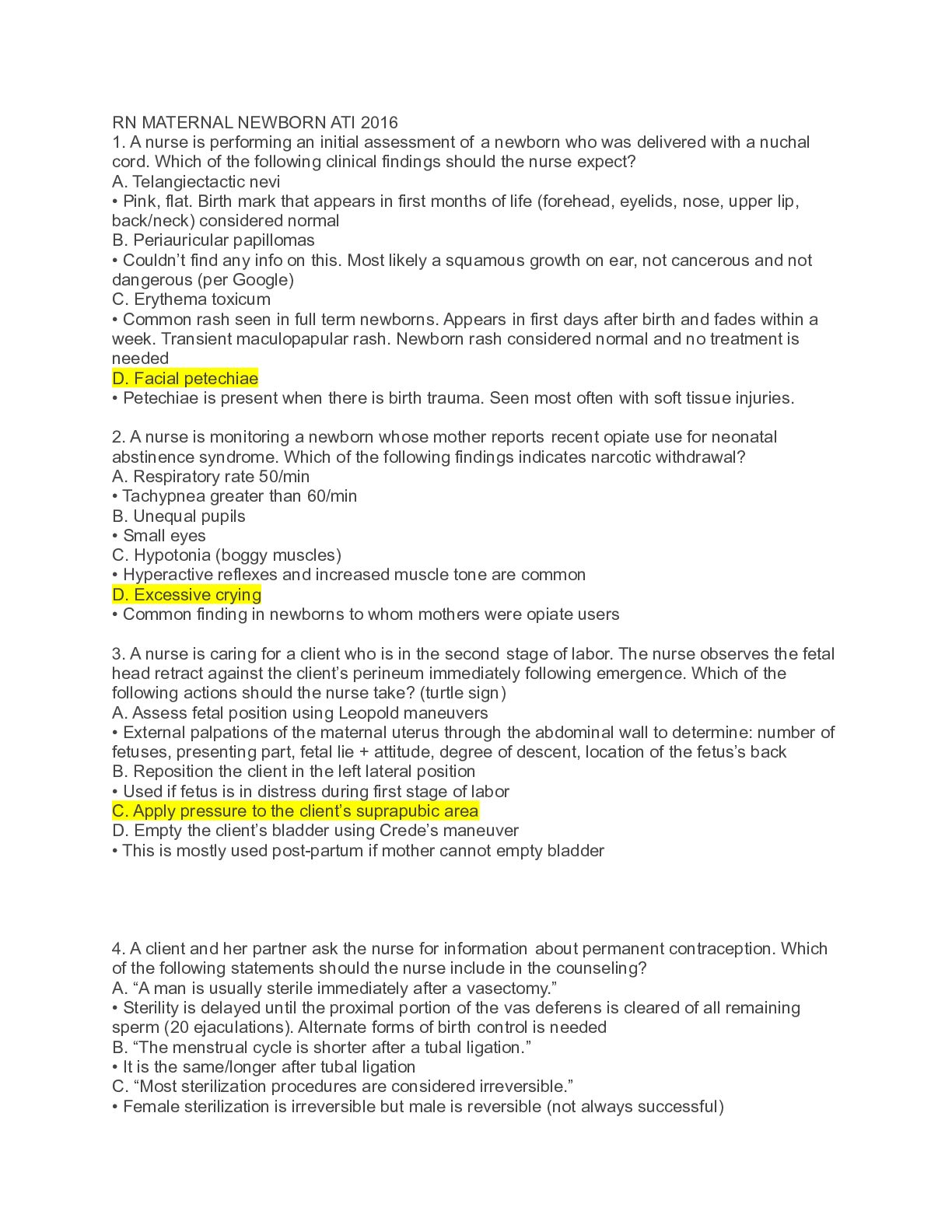
Reviews( 0 )
Document information
Connected school, study & course
About the document
Uploaded On
Jul 05, 2021
Number of pages
13
Written in
Additional information
This document has been written for:
Uploaded
Jul 05, 2021
Downloads
1
Views
156

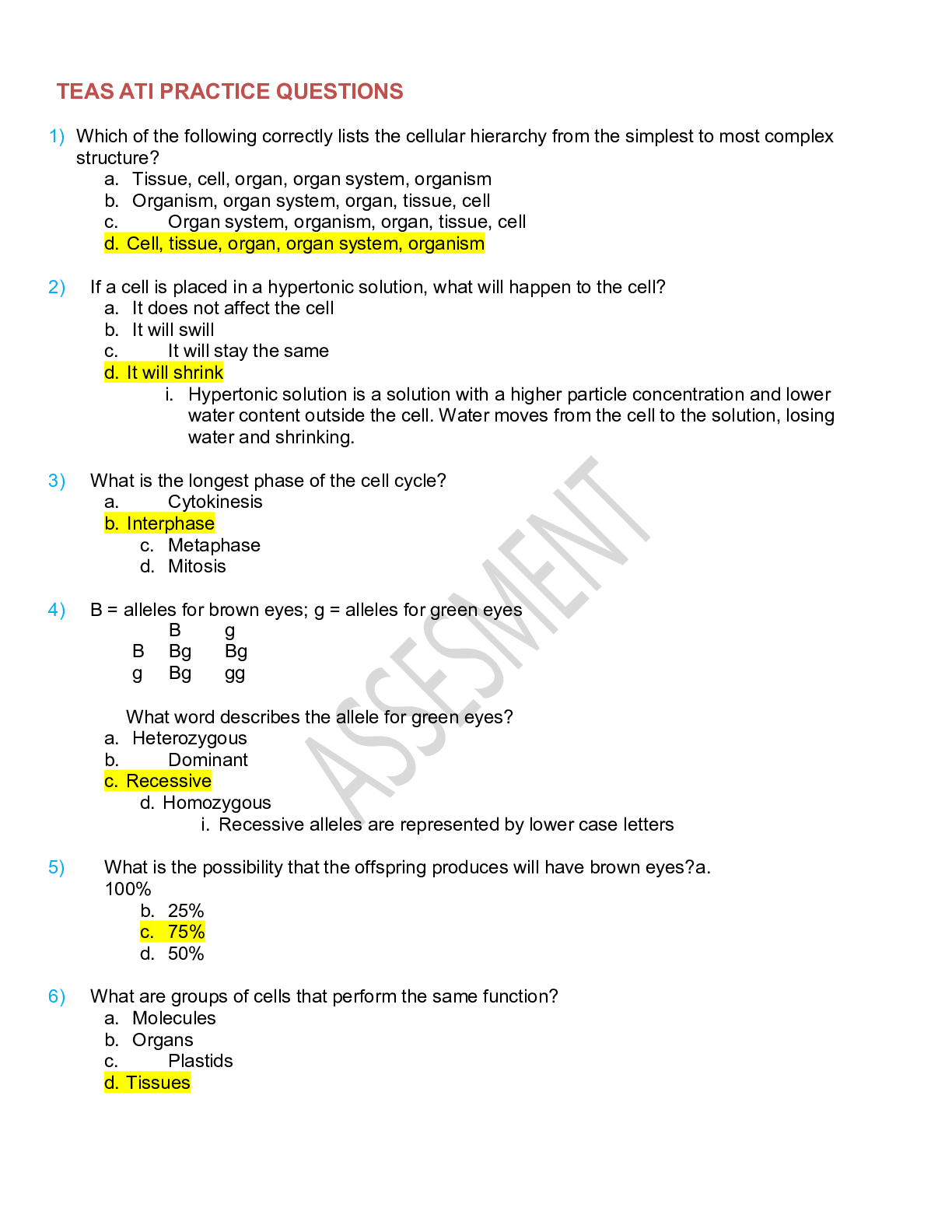
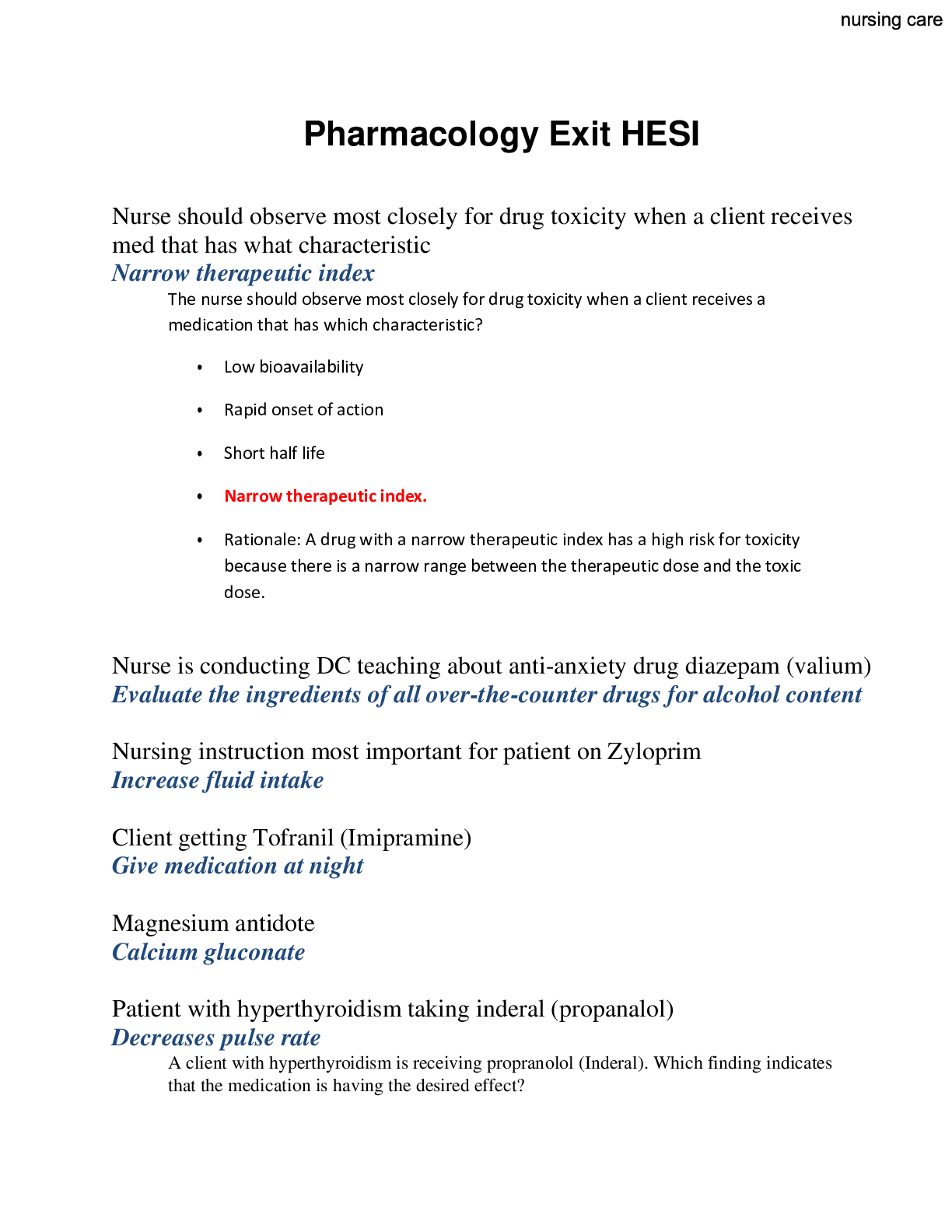

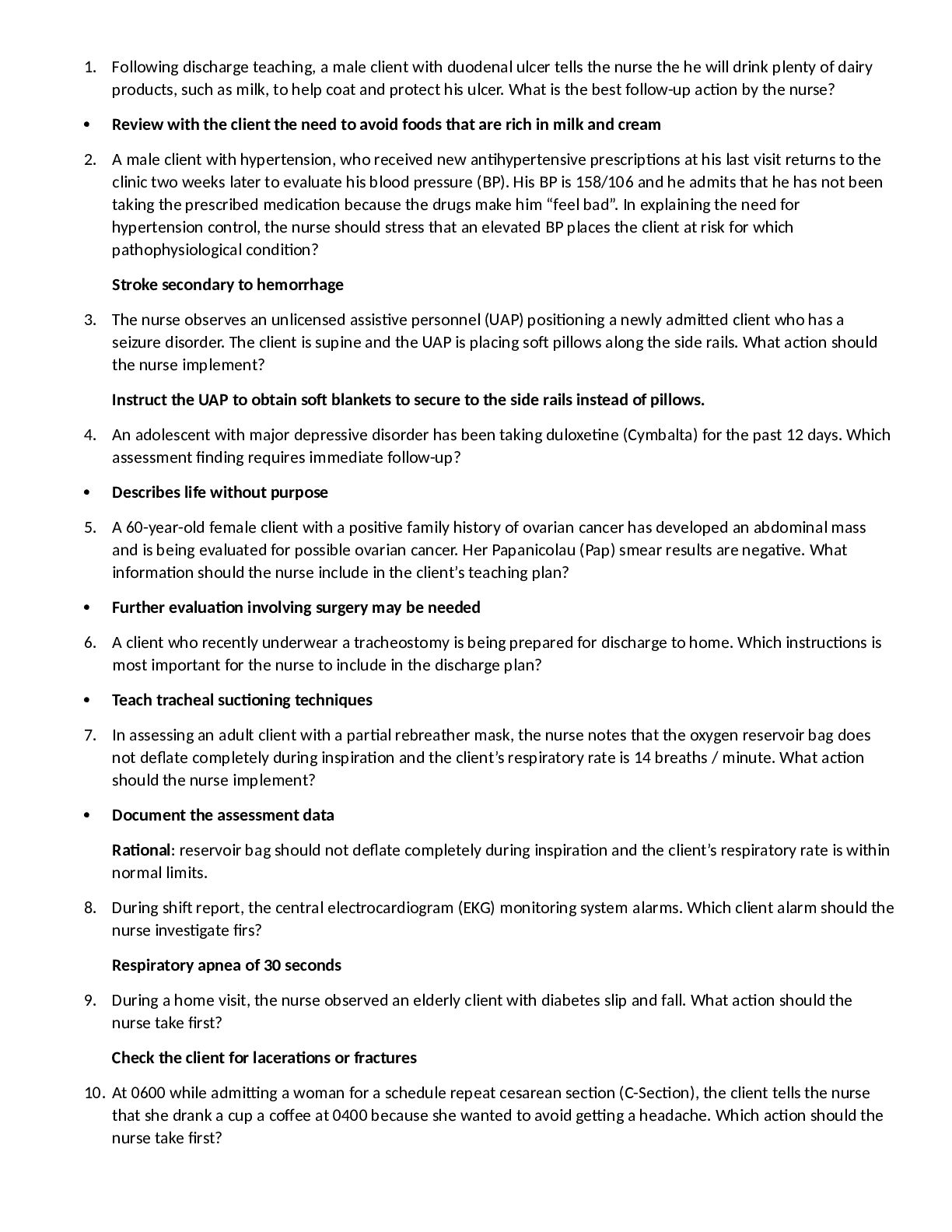
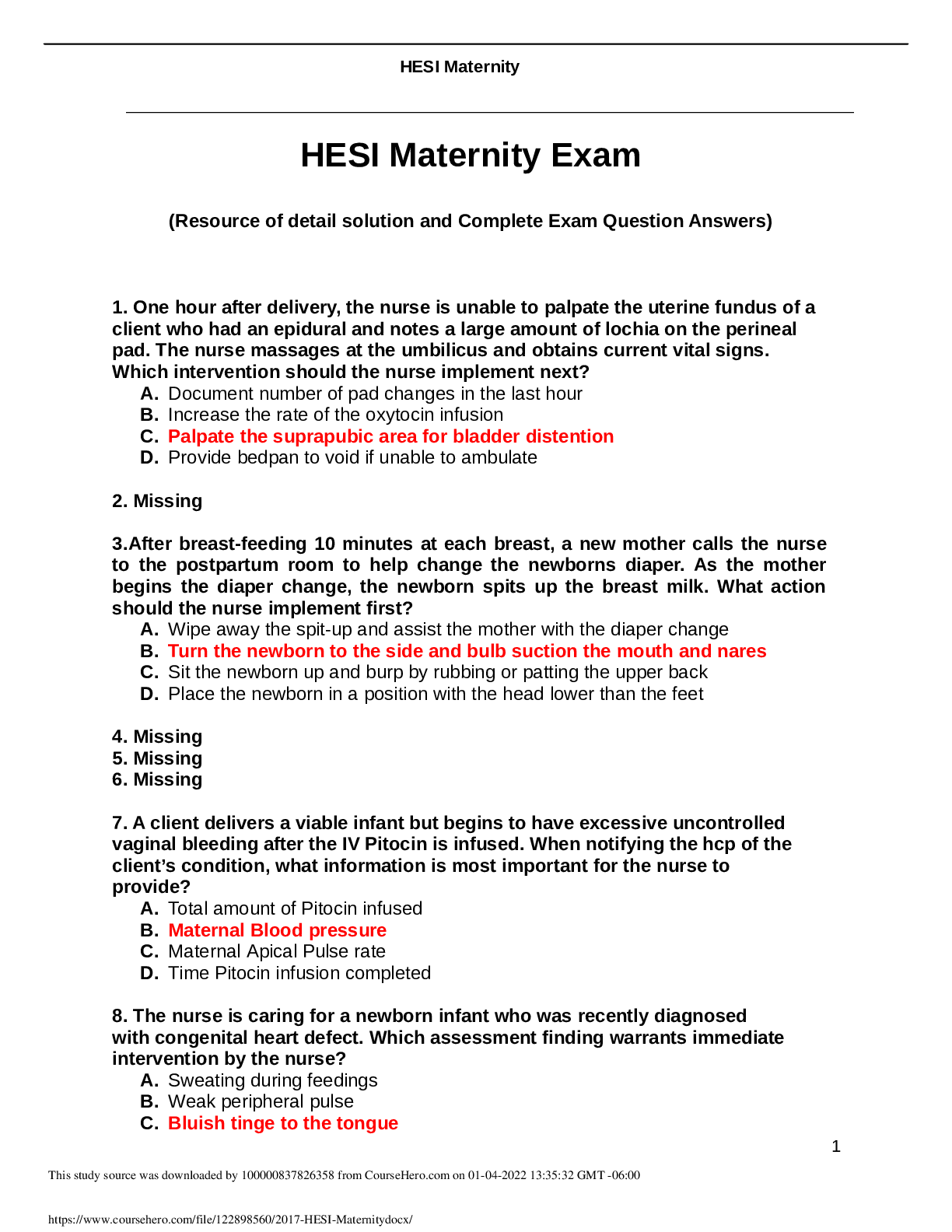
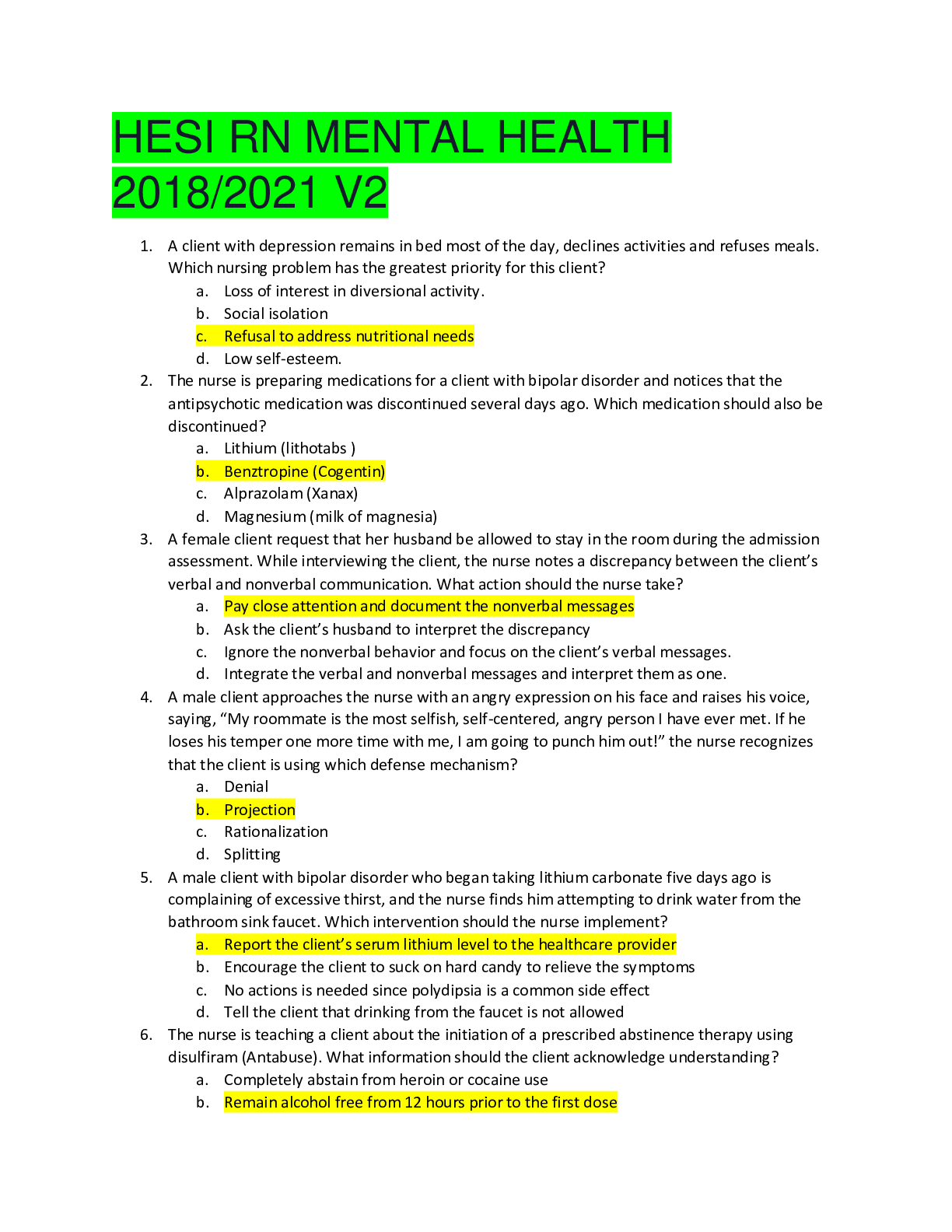

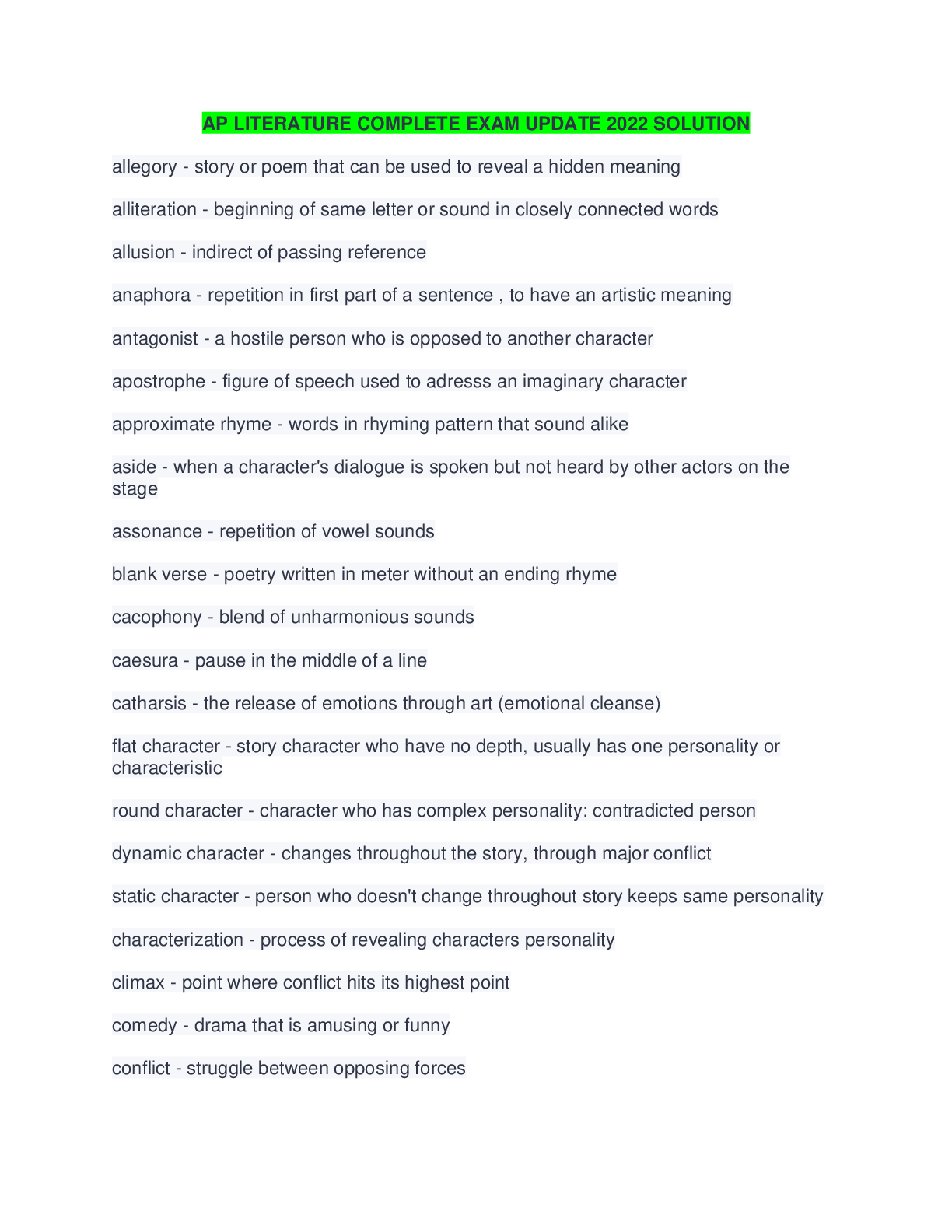
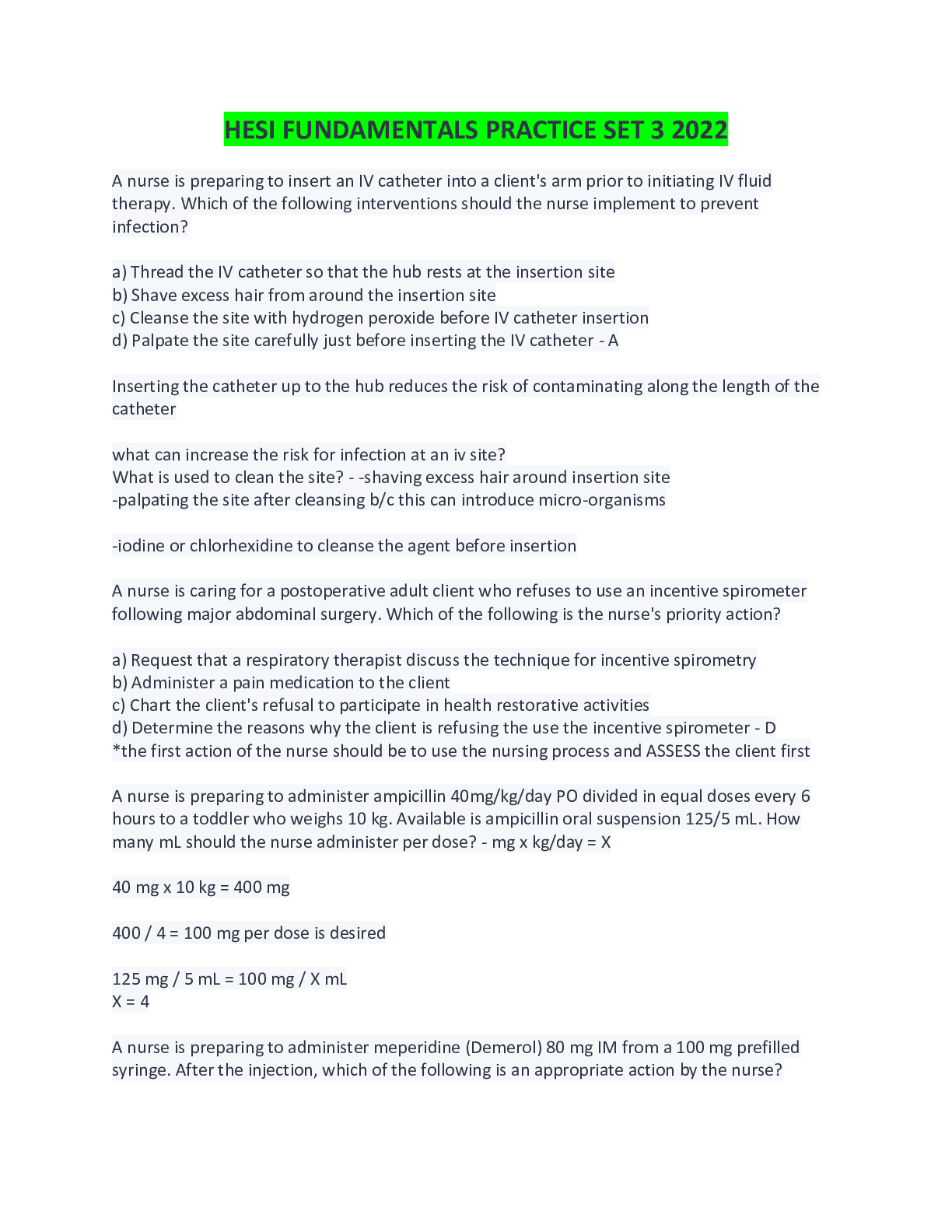
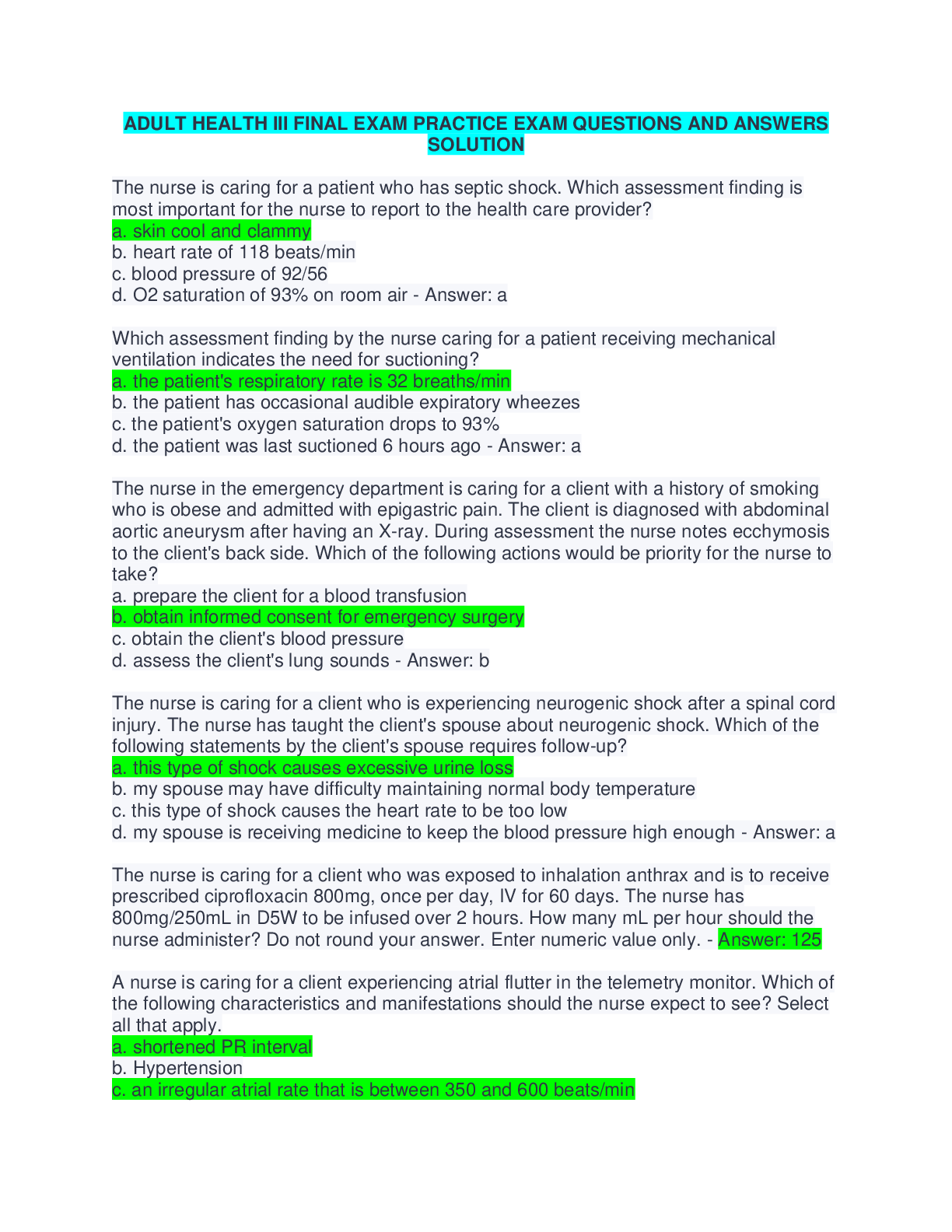

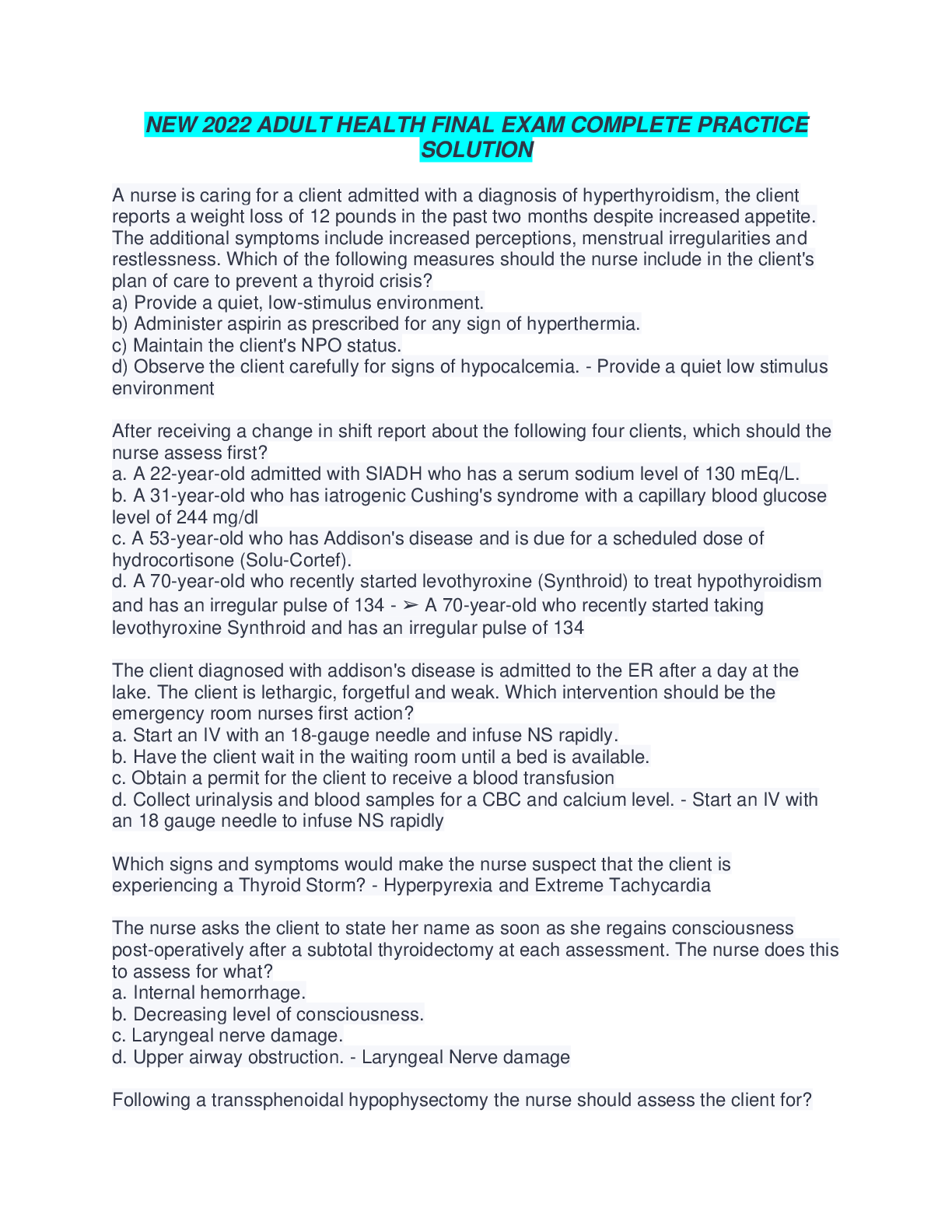
 GRADED QUESTIONS AND ANSWERS.png)
